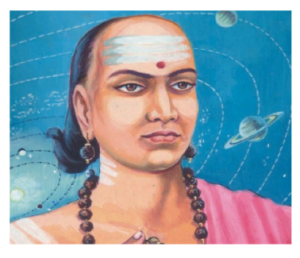Aryabhata is also known as Aryabhata I or Aryabhata the Elder He was born in the year 476 AD at Ashmaka or Kusumapura, India. He was the first Indian mathematician whose work and biography were acknowledged by contemporary scholars . He rose to fame as a mathematician during the Gupta dynasty. Aryabhata’s major contributions to mathematics include the approximation of the value of Pi, as well as other equations related to Algebra and Trigonometry.
His Pi calculation is far more precise than the Greeks’ and is widely accepted among mathematicians. Another contribution was the pre-Galileo concept of the Earth rotating on its axis and its revolutions causing seasonal changes.

To distinguish him from the similarly named 10th-century Indian mathematician of the same name, he is also known as Aryabhata I or Aryabhata the Elder. He flourished near Pataliputra (Patna), the capital of the Gupta dynasty at the time, and wrote at least two works, Aryabhatiya (c. 499) and the now-lost Aryabhatta Siddhanta.
The Aryabhatta Siddhanta was primarily distributed in northwest India and had a significant impact on the development of Islamic astronomy during Iran’s Ssnian dynasty (224–651).
A few of its contents were saved and nurtured by Varahamihira (circa 550), Bhaskara I (circa 629), Brahmagupta (598–c.) and others.
It is one of the first astronomical works to assign midnight as the start of each day.
Aryabhatiya was especially famous in South India, where many mathematicians published commentary over the next millennium. The work is written in verse couplets and is about astronomy and mathematics.
The work is divided into three sections: Ganita (“Mathematics”), Kala-kriya (“Time Calculations”), and Gola (“Sphere”), following an introduction that includes astronomical tables and Aryabhata’s system of phonemic number notation in which numbers are represented by a consonant-vowel monosyllable.
The first ten decimal places are named in Ganita Aryabhata, and procedures for deriving square and cubic roots using the decimal number system are given. Then he discovers features of identical right-angled triangles and two intersecting circles using 62,832/20,000 (= 3.1416), which is extremely near to the actual figure of 3.14159.
He acquired one of the two approaches for building his table of sines using the Pythagorean theorem. He also realized that the difference between second and third-order sines is proportional to sine.
Among the arithmetic and algebraic concepts covered are mathematical series, quadratic equations, compound interest (using a quadratic equation), proportions (ratios), and the solution of various linear equations.
Breaking the problem down into new problems with gradually smaller coefficients was Aryabhata’s general solution for linear indeterminate equations, which Bhaskara I called kuttakara (“pulverizer”). This was essentially the Euclidean algorithm and connected to the
The book ‘Aryabhatiyam’ is divided into four Chapters and includes cosmic theories. They are related to:
- The astronomical constants and the sine table,
- Mathematics required for computations,
- Time-division and procedures for calculating planet longitudes using eccentrics and epicycles,
- The armillary sphere, guidelines for trigonometry issues, and eclipse research.
Date and location of birth
Aryabhatta mentions in the Aryabhatiya that it was written when he was 23 years old, 3,600 years into the Kali Yuga. This corresponds to the year 499 CE, implying that he was born in 476.
Aryabhatta gives no information about his birthplace. Bhaskara I is the only source of information, describing Aryabhatta as asmakiya, or “one from the Asmaka country.” During the Buddha’s time, a branch of the Asmaka people settled in central India between the Narmada and Godavari rivers, where Aryabhatta is said to have been born.
Education
It is almost certain that he went to Kusumapura for advanced studies and lived there for a while. Kusumapura is identified as Pataliputra, modern Patna, by Hindu and Buddhist tradition, as well as Bhaskara I (CE 629). Aryabhatta was the head of a Kusumapura institution (kulapa), and because the university of Nalanda was in Pataliputra at the time and had an astronomical observatory, it is speculated that Aryabhatta was also the head of the Nalanda university. Aryabhatta is also said to have built an observatory at Taregana’s Sun Temple in Bihar.
Works
Aryabhatta wrote several treatises on mathematics and astronomy, some of which have since been lost. His major work, Aryabhatiya, a mathematical and astronomical compendium, was widely cited in Indian mathematical literature and has survived to the present day. The Aryabhatiya’s mathematical section includes arithmetic, algebra, plane trigonometry, and spherical trigonometry. It also includes a table of sines, continued fractions, quadratic equations, sums-of-power series, and quadratic equations.
In conclusion:
Aryabhata’s legacy is truly unparalleled, and no one has ever been able to replicate his major achievements at a world-class level that are still relevant today. His forward-thinking approach was noteworthy. Let us now examine Aryabhatta Inventions and Aryabhatta Discoveries.
 Profile
Profile Settings
Settings Refer your friends
Refer your friends Sign out
Sign out













